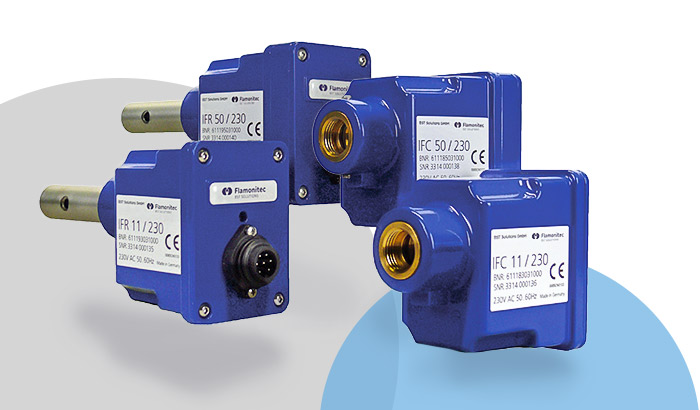Flame detector: function and application
Safe, reliable and low-maintenance – the requirements for flame monitoring are high. After all, the flame detector fulfils a crucial function: it ensures the safe operation of a burner by monitoring the system and shutting it down in the event of a malfunction. In this article, we would like to introduce you to the design, the functional principle and the areas of application of our flame detectors.
The construction
Flame detectors consist of various assemblies. In order for flame detectors to be able to detect a flame, they require a sensor (flame sensor). This sensor converts the flame radiation into a voltage or current signal. This signal is then processed by an amplifier for signal evaluation. In this signal evaluation, which consists for example of a microprocessor, it is decided on the basis of the signal whether the flame is “On” or “Off”. A relay is then switched “On” or “Off” accordingly. To ensure that the optimum flame signal can always be detected for the different applications (UV, daylight and infrared ranges), the following sensors can be used:
- optical sensors
- Ionisation electrodes (flame rod)
- thermocouples
- Acoustic sensors
The task of the flame detector is to switch off in good time if the flame is weak or has gone out. If there is a fault, i.e. the flame is too weak or has gone out, a signal is sent to the burner control unit, which then switches off the entire system for safety reasons. This prevents, for example, gas from being fed into the combustion chamber in an uncontrolled manner, thus increasing the risk of explosion. To fulfil this function, flame detectors use the above-mentioned sensor variants. The signal is then forwarded to an evaluation unit. The special feature here is that each of our flame detectors has its own independent approval and can therefore be easily integrated into the existing burner control system.
The functional principle of our flame detectors
We use an optical flame detector for our flame detectors. The sensors convert flame radiation in different wavelength ranges into electrical signals so that the flame signal can be digitally evaluated. This means that systems that are not suitable for other methods can also be monitored. These include, for example, plants that burn biomass. There are also other advantages:
- Fast flame detection
- Distance to the flame
- Suitable for all types of fuels with carbonaceous to carbon-free flames
- Less susceptible to failure due to robustness against contamination by dust, grease, etc. from the environment or components from biomass, landfill gas, sewage gas, biogas and gases from fracking processes
- Wear-free (our models KLC20/2002; IFR/IFC400)
- The right choice of sensors results in the optimal balance between safety and availability
Safety is the first essential function of our flame detectors. As soon as there is a fault, they reliably switch off the system. However, if the flame sensor is set too sensitively, this means that units are switched off without any actual need. This can cause cold flats in private households and costly downtimes in industrial applications. For this reason, the functional principle of flame detectors is always in the area of conflict between safety and availability.
High quality for reliable availability
To resolve this conflict, we develop our flame detectors to the highest quality standards and with the most modern technology. Various processes are used in the process:
- Complete final testing of all units
- Sub-assembly testing of all components installed by us
- Quality standards already in the development phase
- Consulting and individual product development for our customers
Before we develop a flame monitoring system for a customer, we carry out a detailed application analysis and, based on this, provide comprehensive advice. On this basis, we design our devices as precise but also robust solutions. In this way, we ensure the reliable function of our flame detectors for the respective application.
Application areas
Our flame detectors can be used universally, independent of specified automatic firing systems. Since we focus on customised designs, original equipment manufacturers benefit from flexible integration of our solution into their specific firing systems. BST flame detectors are autonomously approved and can be directly integrated into a wide variety of control processes. This makes them suitable for a wide range of applications, from domestic gas burners to large-scale systems such as industrial pizza ovens.
